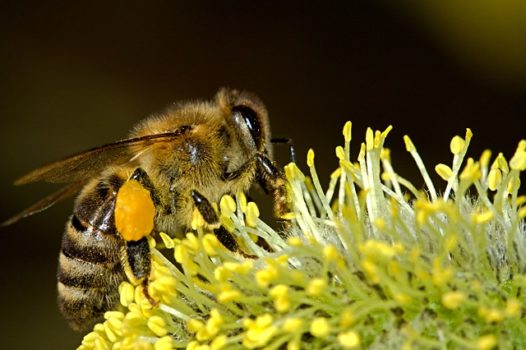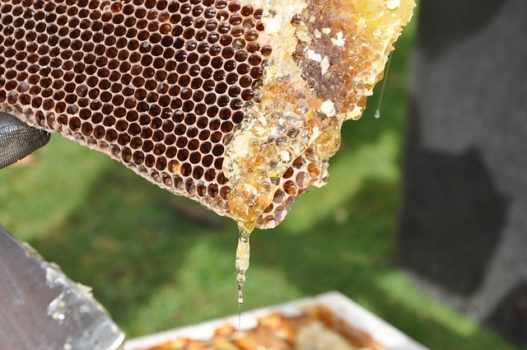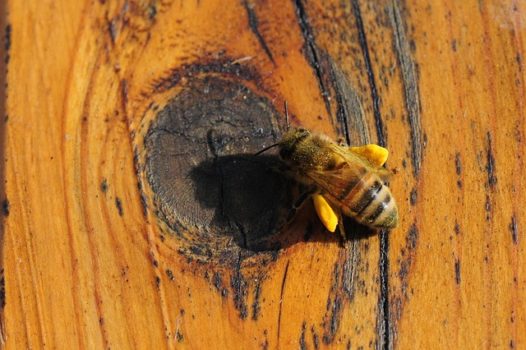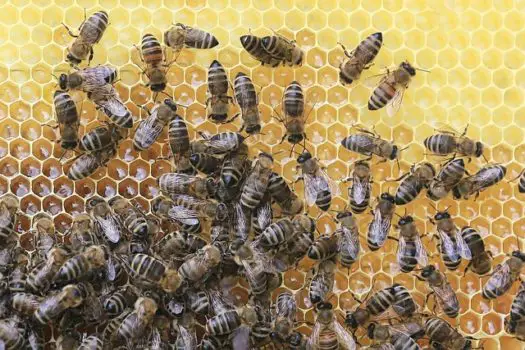The Russian Honey Bee is More resistant to Varroa Mites.
If you are a beekeeper, then you know the dreaded Varroa Mite. These lousy parasites can take down the health and can even kill a healthy honey bee colony. There are some strains of honey bees that are resistant to varroa mite. These are Russian honey bees and Saskatraz honey bees.
I have been a beekeeper of Russian honey bees for a few years now and love them. They are hearty and do well in the cold conditions where I keep my hives. I will let you know what I have found about them and how they have worked for me.
Varroa Mites
Varroa mites are terrible parasites that will propagate in a bee colony and become a nuisance, effect the health, and eventually can kill the colony. These mites will attach themselves to a honey bee and feed off the blood of the bee. While feeding off the bee they will spread viruses, disease, and harmful funguses.
In the reproduction cycle of the Varroa mite they lay eggs into a brood cell. As the bee egg hatches so does the mite egg. There are about 10 varroa mite eggs laid per one honey bee brood cell. Generally, one male varroa mite egg and the rest are female. When the bee emerges from the brooding cell so do the varroa mites. They then spread throughout the hive. This essentially creates exponential growth of the varroa mite which infests a hive.
These mites have been linked to the death of many honey bee colonies worldwide. The stress caused by these parasites has been felt by the honey bee community worldwide. Which results in death of honey bees, honey bee colonies, poor pollination, and colony collapse.
I have a more in-depth article on the varroa mite here. I discuss more of the effects, causes, and cures for the varroa mite.
Russian Honey Bee History
Honey bees from far-eastern Russia proved to be resistant to the varroa mite according to the United States Department of Agriculture. An interesting article can be found here. https://www.ars.usda.gov/southeast-area/baton-rouge-la/honeybeelab/docs/resistance-to-varroa-in-russia/
As transportation got easier in Russia with the Trans-Siberian railway goods and supplies were increasingly transported to the far eastern part of Russia. Honey bees were transported to the Pacific coast of Russia where the varroa mite naturally occurred. This occurred in the mid 1800’s. It is believed that this introduction to the varroa mite at this time lead to the development of a genetic resistance to the varroa mite.
Fast forward to 1995-1996 Russian hives were tested in the Primorsky province of Russia. The Russian bees had significantly less infestation than other domestic honey bee colonies. They still had varroa mites present in the hives, just less of them compared to the domestic colonies.
USDA Russian Bee Testing
In 1999 and the year 2000, the USDA did some field trials in several states of the Russian honey bees. They did the trials in Iowa, Louisiana, and Mississippi with interesting results.
There were several colonies located in each state and inoculated with varroa mites and tested after 91 days. The predicted growth rate for domestic colonies wat about 17.5 percent. The growth rate of the Russian colonies was a lot less. The Louisiana colonies reported only 2.5 percent growth rate and the Iowa and Mississippi colonies reported no to very few varroa mites detectable.
Are Russian Bees free of Varroa Mites and the answer to the Varroa Mite problem?
From the studies it looks like Russian bees could be a possible answer to the varroa mite problem. The Russian honey bees show that they have a resistance to the varroa mite, but not an eradication of the mites. The varroa mites have a difficult time reproducing their normal way with the Russian bees. That is, they don’t do well with the traditional laying of eggs with the honey bee egg in the brood cell, attaching to the brood, and living their normal life cycle in the hive. However, this is not the only way the varroa mite will infest the hive.

As the bees go out to collect nectar and pollen, they collect more than just that. Varroa mites from other honey bees can be left at collection sites. At these collection sites any bee, including Russian bees, also collect the little varroa mites that will hang on and hitch a ride back to the hive. As the nectar and pollen are gathered so are the varroa mites and can begin to infest the hive.
Varroa mites are also spread by robber bees. Honey bees are opportunistic. If they sense a weaker hive, they will become robbers of that hive. So, if another hive is weakened by a varroa mite infestation then the stronger colony will rob as much as they can. This will also include bringing the varroa mites from the weaker hive to your stronger hive.
Russian honey bee behavior
A trait that seems to help with the lower varroa mite count in a Russian honey bee colony is their behavior. They are a little bit more finicky about cleanliness. The workers seem to do a better job at cleaning themselves. They are fastidious little creatures wanting to keep things ship shape. This cleaning behavior seems to aid in keeping the varroa mite population down.
My experience with Russian honey bees.
I have been keeping some Russian honey bee hives for a few years now. I have found them to be similar in nature to Italian honey bees. Their temperament is fairly docile and seem to be good natured. I have noticed that they produce a large amount of propolis sealing up every corner or crack.

The Russian honey bees have been good honey producers from the first season on. I pulled/harvested honey in September the first year after setting up the hive in April producing 42 pounds of honey. The next year I pulled/harvested honey in June producing 30 pounds of honey. I pulled/harvested from the same hive in September of that year producing 70 pounds of honey.
I have not done any propolis harvesting or pollen harvesting with these colonies. I have observed that the colonies that I have worked with create a large amount of propolis. The pollen accumulation seems to be about the same as my other honey bee varieties.
I have not treated my hives with any mite treatments or antibiotics. I have found the mite treatments have done more harm than good to my bees. There is also a concern by many beekeepers that the treatments of the varroa mites are creating a stronger strain of mite that is resistant to the treatments anyway. I am trying to have colonies that are as natural as I can make them
The Russian honey bees have wintered well. I have had some challenges with Italian and Carniolan bees. Some years Italian and Carniolan bees have swarmed in November. Some years the Italian and Carniolan are dead with ample supplies of honey and bee bread. The Russian bees have wintered over well and been very robust in the spring when winter breaks.

Summary
Russian Honey Bees have had good resistance to varroa mites. They are not a silver bullet for the varroa mite issue but are good at keeping varroa mite populations lower than other honey bee varieties. I have had good success with Russian honey bees after 2 winters and 2 summer seasons. The bees are still healthy this winter and I am hopeful for the upcoming summer.


4